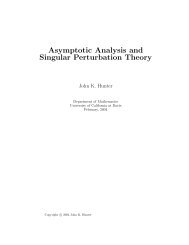PHLST WITH ADAPTIVE TILING AND ITS APPLICATION TO ...
PHLST WITH ADAPTIVE TILING AND ITS APPLICATION TO ...
PHLST WITH ADAPTIVE TILING AND ITS APPLICATION TO ...
You also want an ePaper? Increase the reach of your titles
YUMPU automatically turns print PDFs into web optimized ePapers that Google loves.
8 ZHIHUA ZHANG <strong>AND</strong> NAOKI SAI<strong>TO</strong><br />
∑<br />
Proposition 1. For ε > 0, take n = M n k , where n k is stated in (13). Let V(x)<br />
k=1<br />
and V n (x) be stated in (10) and (11), respectively. Then<br />
‖V −V n ‖ L p (Q) ≤ ε 4 .<br />
From the construction of V n , we know that V n (x) is a piecewise sine polynomial<br />
which is determined by n coefficients. From (13), we get the approximation order<br />
of V(x) by piecewise sine polynomials V n (x).<br />
Proposition 2. Let V(x) and V n (x) be stated in (10) and (11). Then the following<br />
estimate holds:<br />
(<br />
‖V −V n ‖ Lp (Q) = O n −α k 0<br />
)<br />
2 +s′ + 1 p −1 2<br />
(2 ≤ p < ∞),<br />
where α k0 is stated in (9) and s ′ > 0 is an arbitrarily small number.<br />
Proof. By (13), we get<br />
n ≤<br />
M∑<br />
( 4Ck M<br />
k=1<br />
ε<br />
k=1<br />
) (<br />
α k<br />
2 −s ′ − 1 p +1 2) −1 .<br />
By (9): α k0 = min{α 1 ,...,α M }, we have<br />
α<br />
( k0 ( 4<br />
2<br />
n ≤<br />
ε) −s′ − 1 p +1 2 )−1 ∑ M (<br />
)<br />
(C k M) (α k<br />
2 −s ′ − 1 p +1 2 )−1 J k (ε) , (14)<br />
where J k (ε) = ( 4<br />
ε<br />
we have<br />
k=1<br />
(<br />
αk<br />
(<br />
) (<br />
α k<br />
2 −s ′ − 1 p +1 2) −1 αk0<br />
− 2 −s′ − 1 p +1 2<br />
) −1<br />
. By p > 2 and 0 < α k0 ≤ α k ,<br />
) −1 (<br />
αk0<br />
−<br />
2 −s′ − 1 p + 1 ) −1<br />
≤ 0.<br />
2<br />
2 −s′ − 1 p + 1 2<br />
So J k (ε) ≤ 1. From this, we get<br />
M∑<br />
M∑<br />
(C k M) (α k<br />
2 −s ′ − 1 p +1 2) −1 J k (ε) ≤ (C k M) ( α k<br />
2 −s ′ − 1 p +1 2 ) −1 = O(1),<br />
where the constant in the term “O” is independent of ε. Again, by (14),<br />
⎛<br />
(<br />
n = O⎝<br />
4<br />
ε) ( α ) k0 −1<br />
⎞<br />
2 −s′ − 1 p +1 2<br />
⎠.<br />
k=1<br />
This implies that<br />
ε<br />
(<br />
4 = O n −α k 0<br />
)<br />
2 +s′ + 1 p −1 2<br />
. (15)<br />
By (10), (11), and (12), we get<br />
M∑<br />
‖V −V n ‖ L p (Q) ≤ ‖vk ∗ −σ nk (vk)‖ ∗ L p (Q k ) ≤ ε 4 .<br />
From this and (15), we have<br />
Proposition 2 is proved.<br />
‖V −V n ‖ L p (Q) = O<br />
k=1<br />
(<br />
n −α k 0<br />
)<br />
2 +s′ + 1 p −1 2<br />
(s ′ > 0).
















